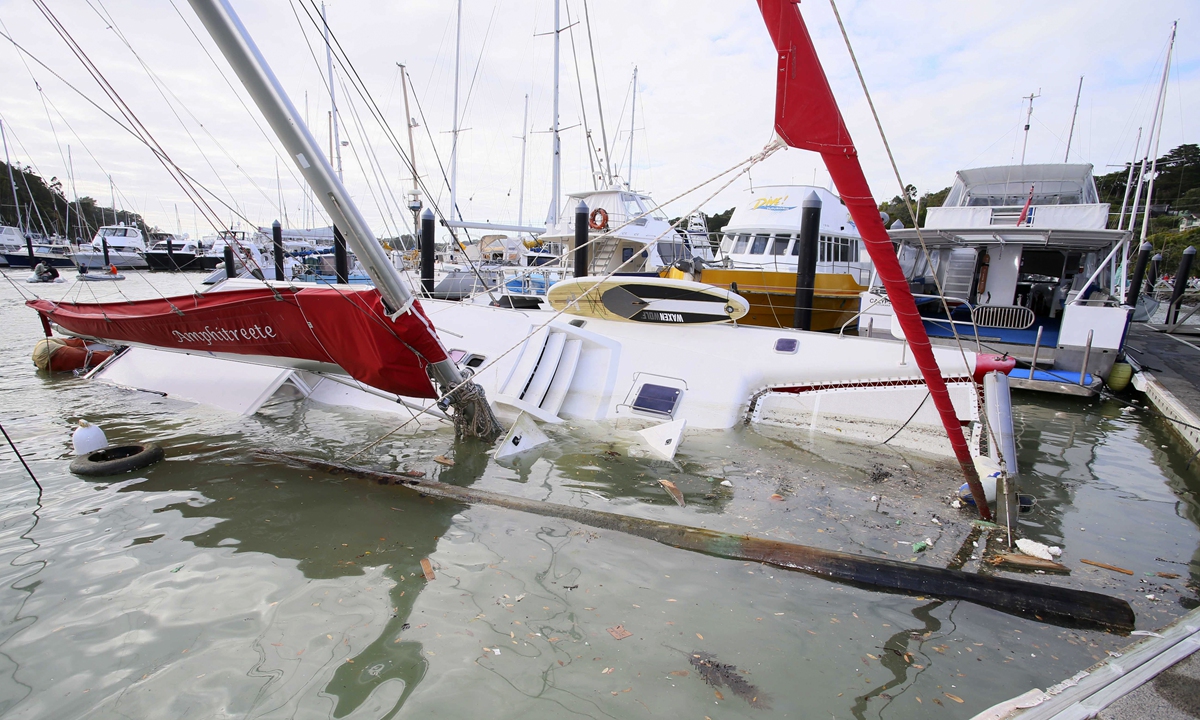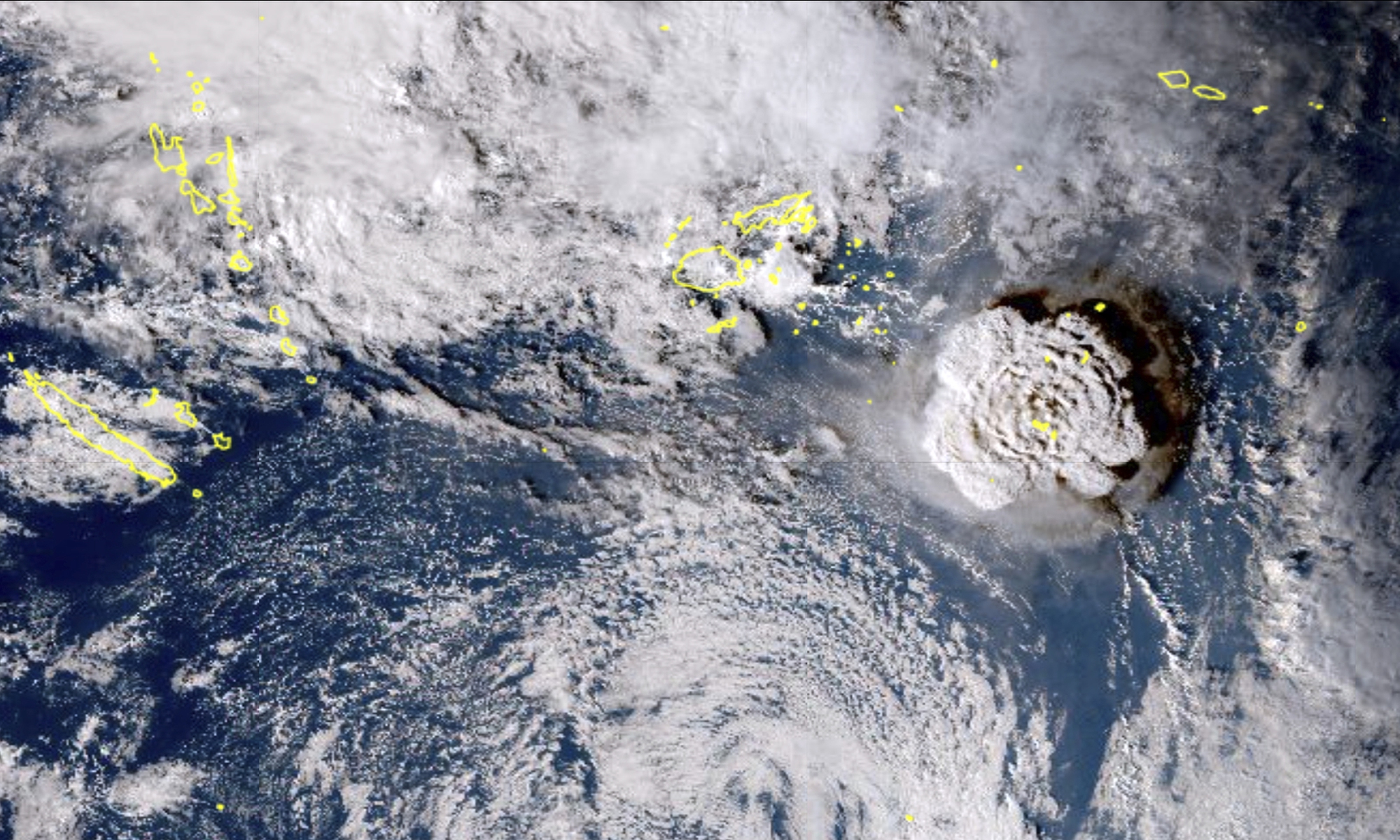No deaths, injuries of Chinese nationals in strong volcanic eruption
The United Nations and many countries have expressed their readiness to help Tonga recover from disastrous tsunamis. The Chinese Foreign Ministry said on Sunday night that China is very concerned about the volcanic eruption off Tonga, tsunamis, volcanic ashes and other disasters it triggered.
“China and Tonga are comprehensive strategic partners. China expresses deep sympathy and sincere condolence to its people and is ready to provide support within its capacity upon the Tongan request,” Foreign Ministry spokesperson Wang Wenbin said on Sunday.
The undersea Hunga Tonga Hunga Ha’apai volcano some 64 kilometers north of Tongan capital Nuku’alofa erupted violently with explosive force on Saturday, triggering tsunami warnings across the South Pacific and the West Coast of the US, and causing strong waves and currents in many coastal areas, the New York Times reported.
Ash rained down across the islands, blocking out the sun, residents told media. The ash column reached around 30 kilometers high, meaning it punched into the stratosphere.
Officially named the Kingdom of Tonga, the South Pacific island country is an archipelago of 169 islands, of which 36 are inhabited. It has a population of around 105,000 and has close ties with New Zealand and Australia.

Photo:CFP
New Zealand Prime Minister Jacinda Ardern said that parts of Nuku’alofa on the main island of Tongatapu suffered “significant” damage but there have been no reports of injuries or deaths.
“The tsunami has had a significant impact on the foreshore on the northern side of Nuku’alofa with boats and large boulders washed ashore,” Ardern said on Sunday, ABC News reported.
Communications with the Pacific island have been cut since Saturday’s eruption damaged the undersea cable but Ardern said her government had made contact with the New Zealand High Commission in the Tongan capital, according to the report.
Families in Tubou, a village on the Fijian island of Lakeba, have packed their belongings and are waiting for instructions as they say it is really hot and they can see airborne ash everywhere, local media reported Sunday.
The Chinese Embassy in Tonga, which was out of reach for a whole day and stirred the nerves of netizens in China, finally confirmed late Sunday that so far there are no reports of deaths or injuries of Chinese nationals.
Zhao Shaofeng, a professor from Research Center for Pacific Island Countries with Liaocheng University in Shandong Province, told the Global Times that he visited Tonga in 2019 just before the outbreak of COVID-19. “Chinese companies helped build roads and other infrastructure there, and Chinese people were generally engaged in retail, hotel and tourism industries.”
Zhao believed the eruption will affect the economy of Tonga and its neighboring countries as they are heavily dependent on outside supply on food and energy, suffering from serious inflation and high rate of unemployment.
But the expert said it will not cause butterfly effect and further affect global supply chain because these islands are not important hubs for crude oil and mines.

The satellite image taken by Himawari-8, a Japanese weather satellite, and released by the agency, shows an undersea volcano eruption near the Pacific nation of Tonga on January 15, 2022.Photo: VCG
No disastrous effect on China
The Tsunami Advisory Center of China’s Ministry of National Resources said in a statement it sent to the Global Times on Sunday that the transoceanic tsunami triggered by the eruption of Hunga-Tonga-Hunga-Ha’apai volcano, which sits on the subduction boundary between the Pacific plate and the Indo-Australian plate, has affected the whole Pacific coastal region.
“Countries including Chile, Japan and New Zealand have monitored tsunami waves with the highest amplitude of 1.5 meters. But the waves have not brought disastrous effects on China’s coast as China monitored tsunami waves earlier on Sunday with a maximum amplitude of roughly 20 centimeters detected in East China’s Zhejiang Province,” said the Tsunami Advisory Center.
Hunga Tonga volcano has erupted several times in recent years, including 2014, 2015, 2019 and 2021. Its eruptions have not stopped as of press time and may last for a few weeks or months, the center said.
Nie Wen, a geological disaster early warning and prevention expert with the Chinese Academy of Sciences, told the Global Times on Sunday that the possibility of continuous quakes and tsunamis cannot be ruled out.
It is very hard to carry out early warning and forecasts for volcano eruptions as they have a very short duration, and current technology would support monitoring of the process rather than early warning in a real sense, he explained.
Echoing Nie, Wang Peitao, an expert with China’s Ministry of Natural Resources, said that compared to the tsunami caused by undersea earthquakes, those caused by volcanic eruptions are more difficult to predict.
China has established an early warning mechanism for tsunami caused by earthquakes that can provide early warning information 8-10 minutes before the waves hit. However, the world has yet to establish a system for tsunami linked to volcanic eruptions, Wang told the Global Times on Sunday.
Wang said the period for tsunami caused by volcano eruptions is shorter than those caused by earthquakes, but they lead to heavier damage to regions and areas adjacent to the volcano.
Expert suspect that the communication outage in Tonga may be a result of undersea cables being cut and unless foreign countries help to repair communication links, it would be hard to restore in the short term.
Amid worries about whether the disaster could completely flood the island country, Yu Lei, chief research fellow at the research center for Pacific island countries of Liaocheng University in East China’s Shandong Province, believes it is unlikely to take place, as it is a relatively big country and residents would be evacuated to the higher ground.
Sharing a similar opinion, Jin Yongxing, former vice principal of Shanghai Maritime University, noted that the island country would not be flooded based on historical records of the region’s volcano activities.
Tonga has experienced successive natural disasters in recent years. In 2018, more than 170 homes were destroyed and two people killed by Cyclone Gita, a Category 5 tropical storm. Two years later, in 2020, Cyclone Harold caused an estimated $111 million of damage, including extensive flooding, according to the New York Times.
Jin suggested that neighboring countries could use maritime satellites to help restore communication and locate residents.
Alert to climate change
An expert from the National Meteorological Center told the Global Times on condition of anonymity that the eruption was one of the strongest in 30 years, which could affect the global climate.
The eruption will influence the trend of La Nina through the interaction between the atmosphere and the ocean. Now the ash has begun to spread westward, which raised people’s alert to the associated extreme weather such as heavy rain, the expert said. Volcanic ash can also produce acid rain.
The intensity and potential impact of a volcanic eruption is generally measured by the Volcanic Explosivity Index (VEI). Although the VEI in Tonga has not yet been determined, the size of the explosion should not be underestimated as the volcano eruption above VEI5 is generally seen as “black swan” in climate change.
The eruption of Mount Tambora on the Indonesian island of Sumbawa in April 1815 was the largest volcanic eruption in the last millennium, according to National Geographic. The Tambora immediate event killed at least 10,000 people and possibly more than 90,000, largely from exposure to the searing hot, toxic swells of gas and rock, it said. The following year, 1816, is known as the year with no summer and was marked by extreme rain and crop failures, leading to famines in the Northern Hemisphere.
The eruption of Mount Pinatubo in the Philippines in 1991 was the world’s largest volcanic eruption in the past 100 years. More than 840 people were killed, with most of the deaths and injuries from the collapse of roofs under wet heavy ash, according to United States Geological Survey.
While scientists do not know if the Tonga eruption would increase the chances of extreme weather in the Northern Hemisphere, analysts warned that a serious of strong volcanic explosions may bring high risks and alter the climate trajectory in the 21st century.
Photo:CFP




